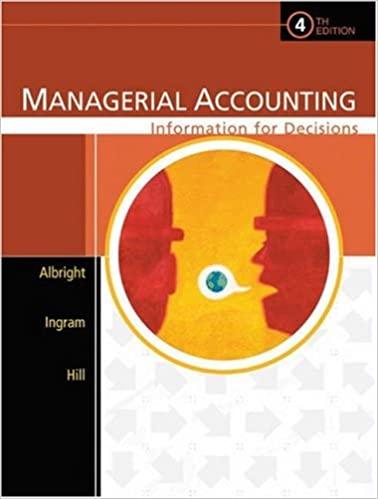Question
1. When a financial analyst examines the credit risk of a company, it is common that he or she uses a set of factors that
1. When a financial analyst examines the credit risk of a company, it is common that he or she uses a set of factors that all begin with the letter "C." Each factor provides a consideration that enters into the lending decision. List and discuss how each of the factors affects a company's credit risk.
ANS:
| 1. | Circumstances leading to need for the loan - The reasons that the company needs to borrow affect the riskiness of the loan and the likelihood of repayment. |
| 2. | Credit History - Has the firm borrowed in the past and successfully repaid the loan. |
| 3. | Cash flows - Is the lender generating sufficient cash flows to pay interest and repay the principal on a loan rather than having to rely on selling the collateral. |
| 4. | Collateral - Is the collateral sufficient to repay the loan and does the lender have the right to take possession of the collateral. |
| 5. | Capacity for debt - Has the company borrowed up to its capacity or is there a margin of safety remaining. |
| 6. | Contingencies - Are there any events on the horizon that would harm the company if their outcome is negative. |
| 7. | Character of management - An intangible factor, has the management team been successful in difficult times, are they honest and forthcoming. |
| 8. | Communication - Developing relations with lenders requires effective communication both initially and on an ongoing basis. |
| 9. | Conditions - What are the restrictions or covenants put in place to protect the lender. |
Each of these factors must be examined in the multivariate manner so that the total credit risk profile of the company can be determined.
2. Given the following information, calculate for Year 2 the number of days of working capital financing the firm will need to obtain from other sources?
|
| Year 1 | Year 2 |
| Accounts Receivable, net | $ 518 | $ 562 |
| Accounts Payable | 203 | 192 |
| Inventory | 535 | 564 |
|
|
|
|
| Credit Sales | 3,205 | 3,636 |
| Cost of Goods Sold | 2,037 | 2,294 |
| Selling and Admin. Expense | 1,081 | 1,131 |
|
3. Refer to the financial statement data for Patriot Corp. for 2011 and 2010. Complete the table by computing the ratios.
Financial Ratio to be calculated:
|
|
| ||||||||||||||||||||||||||||||||||||||||||||||||||||||||||||||||||||||||||||||||||||||||||||||||||||||||||||||||||||||||||||||||||||||||||||||||||||||||||||||||||||||||||||||||||||||||||
|
|
|
| ||||||||||||||||||||||||||||||||||||||||||||||||||||||||||||||||||||||||||||||||||||||||||||||||||||||||||||||||||||||||||||||||||||||||||||||||||||||||||||||||||||||||||||||||||||||||||
Step by Step Solution
There are 3 Steps involved in it
Step: 1

Get Instant Access to Expert-Tailored Solutions
See step-by-step solutions with expert insights and AI powered tools for academic success
Step: 2

Step: 3

Ace Your Homework with AI
Get the answers you need in no time with our AI-driven, step-by-step assistance
Get Started


